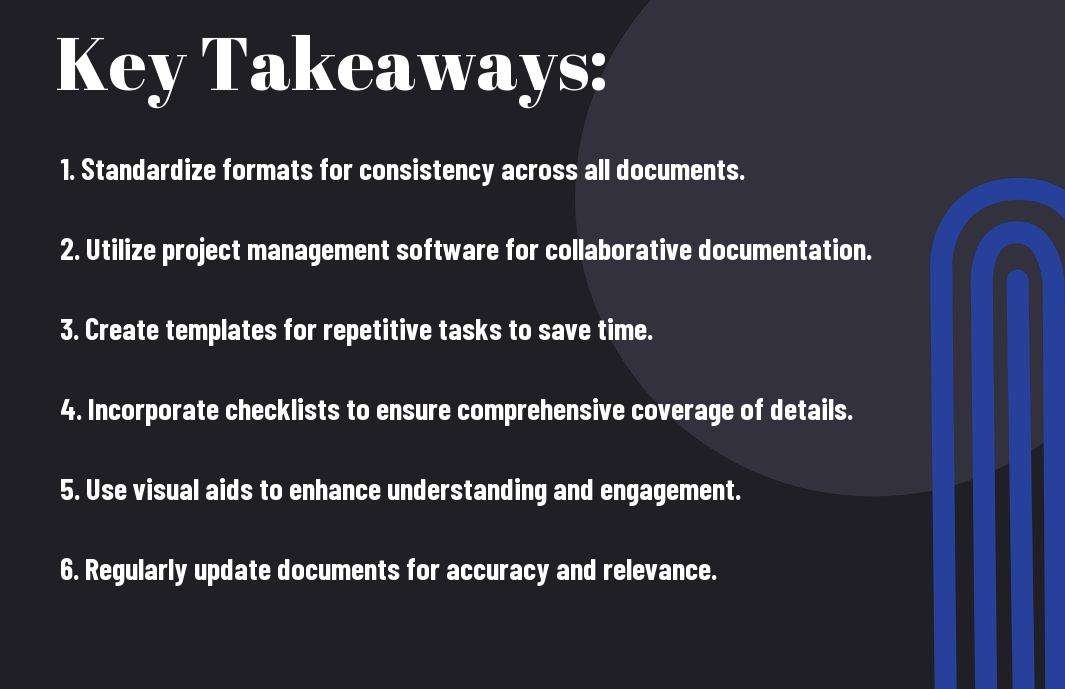Templates can significantly streamline your project documentation process, making it easier to stay organized and focused. In my experience, utilizing standardized templates not only saves time but also enhances the consistency of your documents. I’ll share some of the best tools and templates that have helped me maintain efficiency in project documentation. By implementing these strategies, you’ll reduce errors and improve collaboration within your team. Ultimately, having the right resources can transform your approach and ensure that your projects run smoothly.
Key Takeaways:
- Standardization: Implementing templates promotes uniformity across documentation, making it easier for team members to understand and follow.
- Collaboration: Utilizing collaborative tools allows for real-time updates and input from team members, enhancing communication and reducing errors.
- Efficiency: Pre-designed templates save time by streamlining the documentation process, enabling teams to focus on key project activities.
- Accessibility: Using cloud-based storage ensures that all team members can access necessary documents anytime and anywhere, fostering flexibility.
- Retention: Well-organized project documentation serves as a valuable resource for future projects, enabling teams to learn from previous experiences.
Importance of Project Documentation
A well-structured project documentation is imperative for the success of any project. It serves as a roadmap, guiding team members through processes, objectives, and desired outcomes. Proper documentation ensures that everyone is on the same page, minimizing misunderstandings and facilitating smoother project execution. Additionally, it provides a reliable reference throughout the project lifecycle, allowing for better decision-making and accountability.
Enhances Collaboration
Across teams, effective project documentation fosters collaboration by providing a shared understanding of the project’s goals and progress. When everyone has access to the same information, it creates an environment of transparency and teamwork, ensuring that all contributors can effectively communicate and contribute towards common objectives.
Ensures Compliance
To maintain industry standards and adhere to regulations, ensuring compliance through thorough project documentation is vital. Without proper documentation, you risk overlooking legal requirements or internal policies that can lead to serious repercussions. This oversight can result in financial penalties, severe project delays, or even a complete project shutdown.
A reliable compliance framework can safeguard your project. By maintaining accurate records and documentation, you enhance not just your team’s ability to operate smoothly, but also protect your organization from potential legal pitfalls. Failure to document procedures can lead to litigation and fines, while thorough documentation instills a sense of security and trust in your stakeholders. Therefore, always prioritize a robust documentation process to ensure compliance and enhance overall project integrity.
Essential Tools for Project Documentation
If you want to streamline your project documentation process, having the right tools is imperative. Using specialized tools can help improve efficiency, ensure clarity, and enhance collaboration among team members. In this digital age, I find that leveraging modern technology can significantly ease the burden of documentation tasks and improve overall project success.
Project Management Software
Tools like Asana, Trello, and Jira offer you a robust platform for organizing tasks, tracking progress, and maintaining all project-related documentation in one place. They help to streamline workflows, making it easy to assign responsibilities, set deadlines, and monitor project milestones.
Collaboration Platforms
Across projects, collaboration platforms such as Slack, Microsoft Teams, and Google Workspace significantly enhance communication among team members. These tools enable you to share documents, hold discussions in real time, and keep everyone aligned on project goals and updates.
Software like Slack and Microsoft Teams helps eliminate silos, creating an integrated workspace where every team member can participate. With the ability to discuss changes, share files, and document decisions in one location, information is easily accessible. Additionally, having all conversations archived provides a robust reference point for future projects. This approach can lead to faster decision-making and less chance of miscommunication, ultimately contributing to a more effective project documentation process.

Key Templates for Effective Documentation
All successful projects rely on clear and comprehensive documentation. Utilizing key templates can streamline the documentation process, ensuring that important information is captured in a consistent and organized manner. These templates not only save time but also enhance collaboration among team members, making it easier to track progress and share updates. In this section, I will discuss two imperative templates that can significantly improve your project documentation efforts.
Project Charter Template
Before launching your project, having a well-defined Project Charter Template is imperative. This template outlines the project’s purpose, objectives, stakeholders, and deliverables, serving as a foundational reference throughout the project lifecycle. By investing time in this initial document, you set the stage for effective communication and alignment among all project participants.
Meeting Notes Template
Meeting notes are vital for capturing key discussions, decisions, and action items that occur during project meetings. With a dedicated Meeting Notes Template, I ensure that all attendees have a clear record of what was addressed, which not only aids in accountability but also fosters better follow-up actions. Accurate notes help minimize miscommunication and can be referenced for future meetings, making it easier for everyone to stay on the same page. Additionally, sharing these notes promptly allows team members to align their tasks with agreed-upon action items, enhancing overall productivity.
Best Practices in Document Management
Not adhering to best practices in document management can lead to chaos and miscommunication within your project. I highly recommend reviewing the Effective Project Documentation Best Practice to ensure you’re on the right track. Implementing structured procedures not only streamlines your workflow but also enhances collaboration among team members.
Version Control
An effective version control system is vital in managing project documentation. It allows you to track changes, maintain the history of documents, and avoid confusion over which file is the latest. I advise using version control tools that suit your project size and complexity, ensuring that all stakeholders know where to find the most current information.
Accessibility and Organization
Control over document accessibility and organization is necessary for productivity. Properly organized documentation makes it easy for you and your team to find relevant files when needed. Prioritize using descriptive naming conventions, categorizing documents logically, and ensuring that the right people have access to necessary files. This approach not only saves time but also reduces the risk of errors.
And when documents are systematically organized, your team can operate more effectively. Utilizing strategies like grouping files by project phase or using a centralized repository minimizes chaos. Additionally, ensuring that all stakeholders have the necessary permissions allows for seamless collaboration and communication. Ultimately, the more accessible and organized your documentation, the more streamlined your project will be, leading to better outcomes and a more harmonious team environment.
Leveraging Technology for Efficiency
Your project documentation can significantly benefit from leveraging technology to streamline processes and enhance collaboration. By incorporating various digital tools and templates, you can automate repetitive tasks, organize information more effectively, and ensure all team members have access to the latest documents. This not only saves time but also minimizes errors and improves overall productivity in your projects.
Automation Tools
The use of automation tools allows you to eliminate tedious manual tasks associated with project documentation. From automated reporting and reminders to workflow management systems, these tools can help you streamline processes, ensuring that nothing falls through the cracks and freeing up your time to focus on more strategic aspects of your project.
Cloud Storage Solutions
For effective project documentation, cloud storage solutions provide a flexible and reliable way to store and share files. They enable real-time collaboration among team members, regardless of their location, ensuring that everyone has access to the most up-to-date information.
Also, utilizing cloud storage solutions enhances your project documentation by offering automatic backups and version control features. This means that you can easily track changes and revert to previous versions if necessary, reducing the risk of losing important data. Furthermore, with secure access controls, you can manage who can view or edit documents, ensuring that your project’s sensitive information remains protected from unauthorized access. Adopting these solutions ultimately leads to a more efficient and organised workflow, fostering better communication and collaboration among team members.
Training and Support for Teams
Now, facilitating effective project documentation requires robust training and support for your team. By providing comprehensive resources, you can empower your team to utilize documentation tools and templates effectively. Through structured training sessions and ongoing support, your team can enhance their skills and understanding, leading to improved project outcomes.
Onboarding Resources
At the start of any project, effective onboarding resources are crucial. These materials help new team members quickly grasp your standards and document management systems, ensuring everyone is on the same page from day one. Providing structured guides and tutorials can significantly streamline the onboarding process.
Ongoing Learning Opportunities
Above all, fostering *ongoing learning opportunities* keeps your team’s skills sharp and adaptive. Continuous training sessions, workshops, and access to updated resources will enhance your team’s proficiency in utilizing documentation tools and strategies, ensuring they can keep pace with evolving project needs.
Teams that invest in *ongoing learning opportunities* significantly benefit from *enhanced adaptability and resourcefulness*. With regular access to new learning materials, skill enhancement sessions, and collaborative workshops, you can cultivate an environment where team members feel empowered to *experiment with innovative documentation practices*. This *positive culture of learning* not only enriches individual capability but also fortifies overall project efficiency. Prioritizing these initiatives leads to more successful project outcomes, as team members remain informed and engaged with the latest best practices and tools available in the ever-evolving landscape of project documentation.

Summing up
As a reminder, leveraging the right tools and templates for efficient project documentation can significantly streamline your workflow and enhance collaboration. I encourage you to explore various options that suit your project’s needs, as well as customize templates to fit your specific requirements. By doing so, you can save time, reduce errors, and improve overall project outcomes, making your documentation process not only effective but also a valuable asset as you manage your projects.
FAQ
Q: What are the benefits of using tools and templates for project documentation?
A: Utilizing tools and templates for project documentation streamlines the process of gathering, organizing, and presenting information. These resources help maintain consistency across documents, reduce the time spent on formatting, and ensure that all necessary information is included. Overall, they enhance collaboration among team members by providing a clear structure for communication.
Q: Which types of tools are recommended for creating project documentation?
A: Several types of tools can be beneficial. Document management software like Microsoft SharePoint or Google Docs allows for collaborative editing. Project management tools such as Asana or Trello often include features to attach relevant documents. Additionally, specialized templates in software like Microsoft Word or Excel can aid in creating structured reports and plans efficiently.
Q: How can I ensure that my documentation templates are effective?
A: To create effective documentation templates, consider the specific needs of your project and stakeholders. Include sections for objectives, timelines, responsible parties, and deliverables. It’s also helpful to gather feedback from team members after using the templates, making adjustments based on their insights and experiences to improve clarity and usability.
Q: What should I include in a project documentation template?
A: An ideal project documentation template should incorporate several key components: project title, objectives, scope, stakeholders, timeline, budget estimates, risk assessments, meeting notes, and action items. Additionally, a section for revisions and updates can help track changes over time, ensuring that all team members have access to the most current information.
Q: How can I train my team to effectively use these tools and templates?
A: Training your team can be achieved through workshops or tutorials that demonstrate how to utilize the tools and templates. Provide both written and visual guides to cater to different learning styles. Encouraging hands-on practice through real project scenarios can also help team members feel more comfortable and proficient in using the documentation resources effectively.







